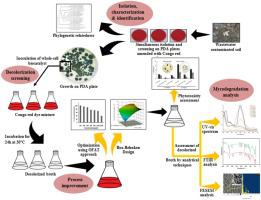Industrial Crops and Products ( IF 5.6 ) Pub Date : 2021-06-21 , DOI: 10.1016/j.indcrop.2021.113755 Barkha Sharma , Shalini Tiwari , Neha Bisht , Lakshmi Tewari

|
Recycling and valorization of noxious dye contaminated industrial wastewater minimize prevailing agricultural water dearth. In this context, the current manuscript investigates and fabricates a rapid, ecofriendly, and cost effective treatment system using a potent dye degrading microbial agent. An agar plug immobilized Penicillium crustosum PWWS-6, a filamentous fungus isolated from veterinary clinical waste dump, for the first time reported to decolorize (81.86 ± 0.03 %) hazardous diazo dye, (Congo red, 100 ppm) in 24 h. Lignin peroxidase, azo reductase, veratryl alcohol oxidase, and NADH-DCIP reductase enzymes were induced significantly during mycoremediation bioprocess which is affected by incubation time, temperature, pH, inoculum volume, and dye concentration of aqueous medium. The one-factor-at-a-time (OFAT) and response surface methodology (RSM) were adopted to optimize these cultural parameters and generated optimized conditions (incubation time, 16 h; temperature, 27 °C; and inoculum volume, 6 fungal discs), for maximum degradation (99.85 %) of 100 ppm CR at pH 7.0. Further, using OFAT approach, P. crustosum also showed 72.14 % degradation of CR at much higher concentration of 1000 ppm in 72 h. UV–vis spectra verified complete disappearance of dye from colored broth. Fourier Transform Infrared (FTIR) spectroscopy along with Field Emission Scanning Electron Microscopy (FESEM) subsequently confirmed (–N=N–) bond destabilization following degradation. Furthermore, the non-toxic degraded metabolites showed improved percent germination, radical and plumule length of Cicer arietinum and Hordeum vulgare seeds compared with untreated CR contaminated wastewater.
中文翻译:

使用琼脂塞固定化壳青霉 PWWS -6 生物质处理被有毒刚果红染料污染的农业用废水的生态友好型生物工艺
有毒染料污染的工业废水的回收和增值可最大程度地减少普遍存在的农业缺水问题。在这种情况下,当前的手稿使用有效的染料降解微生物剂研究并制造了一种快速、环保且具有成本效益的处理系统。琼脂塞固定壳青霉PWWS-6 是一种从兽医临床废物堆放物中分离的丝状真菌,首次报告在 24 小时内使有害重氮染料(刚果红,100 ppm)脱色(81.86 ± 0.03 %)。木质素过氧化物酶、偶氮还原酶、藜芦醇氧化酶和 NADH-DCIP 还原酶在真菌介导生物过程中被显着诱导,其受孵育时间、温度、pH、接种量和水性介质染料浓度的影响。采用一次一个因子 (OFAT) 和响应面方法 (RSM) 来优化这些培养参数并生成优化条件(培养时间,16 小时;温度,27 °C;接种量,6圆盘),在 pH 7.0 时最大降解 (99.85 %) 100 ppm CR。此外,使用 OFAT 方法,P.crustosum还显示 72.14% 的 CR 在 1000 ppm 的更高浓度下在 72 小时内降解。UV-vis 光谱证实染料从有色肉汤中完全消失。傅立叶变换红外 (FTIR) 光谱和场发射扫描电子显微镜 (FESEM) 随后证实了 (–N=N–) 键在降解后不稳定。此外,与未经处理的 CR 污染废水相比,无毒降解代谢物显示出提高了Cicer arietinum和Hordeum vulgare种子的发芽百分比、自由基和胚芽长度。











































 京公网安备 11010802027423号
京公网安备 11010802027423号